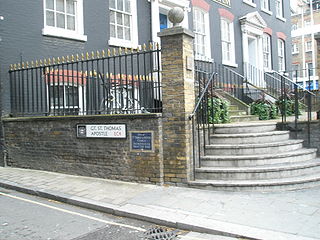
St Thomas the Apostle was a parish church in St Thomas Apostle Street in the City of London. In existence by the late twelfth century, it was destroyed in the Great Fire of London in 1666 and not rebuilt.

St Alban's was a church in Wood Street, City of London. It was dedicated to Saint Alban. Of medieval origin, it was rebuilt in 1634, destroyed in the Great Fire of London in 1666, and rebuilt, this time to a Gothic design by Sir Christopher Wren. It was severely damaged by bombing during the Second World War and the ruins cleared, leaving only the tower.

St. Mary Somerset was a church in the City of London first recorded in the twelfth century. Destroyed in the Great Fire of 1666, it was one of the 51 churches rebuilt by the office of Sir Christopher Wren. The tower is located in Upper Thames Street, the body of the church being demolished in 1871.

St Lawrence Jewry next Guildhall is a Church of England guild church in the City of London on Gresham Street, next to Guildhall. It was destroyed in the Great Fire of London in 1666, and rebuilt to the designs of Sir Christopher Wren. It is the official church of the Lord Mayor of London.
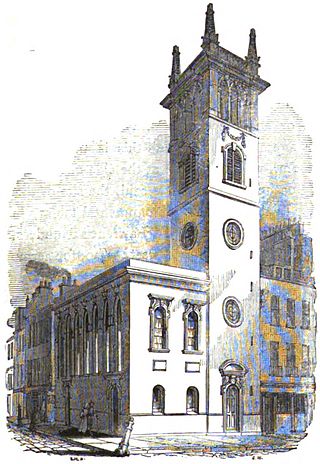
All Hallows Bread Street was a parish church in the Bread Street ward of the City of London, England. It stood on the east side of Bread Street, on the corner with Watling Street. First mentioned in the 13th century, the church was destroyed in the Great Fire of London in 1666. The church was rebuilt by the office of Sir Christopher Wren and demolished in 1876.

All-Hallows-the-Great was a church in the City of London, located on what is now Upper Thames Street, first mentioned in 1235. Destroyed in the Great Fire of London of 1666, the church was rebuilt by the office of Sir Christopher Wren. All-Hallows-the-Great was demolished in 1894 when many bodies were disinterred from the churchyard and reburied at Brookwood Cemetery.
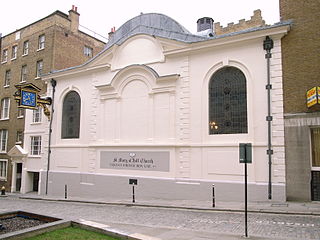
St Mary-at-Hill is an Anglican parish church in the Ward of Billingsgate, City of London. It is situated on Lovat Lane, a cobbled street off Eastcheap.

St George Botolph Lane was a church off Eastcheap, in the ward of Billingsgate in the City of London. The rear of the church overlooked Pudding Lane, where the fire of London started. It was first recorded in the twelfth century, and destroyed in the Great Fire of 1666. It was one of the 51 churches rebuilt by the office of Sir Christopher Wren. The church was demolished in 1904.

St Mary Abchurch is a Church of England church off Cannon Street in the City of London. Dedicated to the Blessed Virgin Mary, it is first mentioned in 1198–1199. The medieval church was destroyed in the Great Fire of London in 1666, and replaced by the present building.

St Benet Gracechurch, so called because a haymarket existed nearby (Cobb), was a parish church in the City of London. First recorded in the 11th century, it was destroyed in the Great Fire of London of 1666 and rebuilt by the office of Sir Christopher Wren. The church was demolished in 1868.

St Michael Bassishaw, or Basinshaw, was a parish church in Basinghall Street in the City of London, standing on land now occupied by the Barbican Centre complex. Recorded since the 12th century, the church was destroyed in the Great Fire of 1666, then rebuilt by the office of Sir Christopher Wren. The rebuilt church was demolished in 1900.

St. Mary Magdalen Old Fish Street was a church in Castle Baynard ward of the City of London, England, located on the corner of Old Fish Street and Old Change, on land now covered by post-War development. Recorded since the 12th century, the church was destroyed in the Great Fire of London of 1666, then rebuilt by the office of Sir Christopher Wren. The rebuilt church suffered damage to its roof from a fire in an adjacent warehouse in 1886. It was not repaired, and was finally demolished in 1893.

St Antholin, Budge Row, or St Antholin, Watling Street, was a church in the City of London. Of medieval origin, it was rebuilt to the designs of Sir Christopher Wren, following its destruction in the Great Fire of London in 1666. The 17th-century building was demolished in 1874.

St Mildred, Poultry, was a parish church in the Cheap ward of the City of London dedicated to Anglo-Saxon Saint Mildred. It was rebuilt after the Great Fire of London, and demolished in 1872. St Mildred in the Poultry was the burial place of the writer Thomas Tusser. Some description of the church and its monuments is given in John Stow's Survey of London.

St Mary Colechurch was a parish church in the City of London destroyed in the Great Fire of London in 1666 and not rebuilt.

St John the Evangelist Friday Street was a church in Bread Street Ward of the City of London. It was destroyed in the Great Fire of London of 1666, and not rebuilt, the parish being united with that of All Hallows, Bread Street.
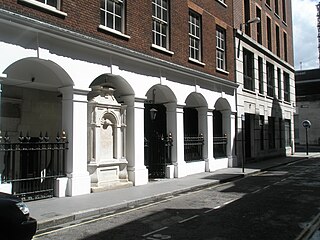
St John the Baptist upon Walbrook was a parish church in the City of London. It stood in Walbrook Ward, with parts of the parish extending into Cordwainer, Dowgate, and Vintry Wards. Of medieval origin, it was destroyed in the Great Fire of London in 1666 and not rebuilt.
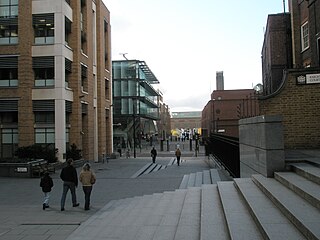
St Peter, Paul's Wharf, was a Church of England parish church in the City of London. It was destroyed in the Great Fire in 1666.
St Mary Magdalen, Milk Street, was a parish church in the City of London, England, dedicated to Jesus' companion Mary Magdalene. Originally constructed in the 12th century, it was destroyed in the Great Fire of London in 1666 and not rebuilt. The location was converted into a market, then from 1835 to 1879 was the site of the City of London School.

St Mary Woolchurch Haw was a parish church in the City of London, destroyed in the Great Fire of London of 1666 and not rebuilt. It came within the ward of Walbrook.




















